Labour market update: March 2019
This briefing provides an overview of the Scottish labour market from the latest regional labour market statistics from the Office for National Statistics (ONS).
Executive Summary
This briefing provides an overview of the Scottish labour market from the latest regional labour market statistics1 and UK labour market statistics published by the Office for National Statistics (ONS)2. The data is for Nov-Jan 2019, unless otherwise stated.
The unemployment rate in Scotland now sits at 3.4%, which is the lowest since comparable records began in 1992. It is currently below the UK-wide figure of 3.9% and is fourth lowest of the regions and nations of the UK. The fall over the quarter was driven by the fall in the the employment rate for women, while the rate for men was unchanged.
The employment rate in Scotland currently sits at 75.3%, which is lower the the UK-wide figure of 76.1%. The increase over the quarter came from the rate for women increasing while the rate for men was unchanged.
Scotland currently has the fourth highest inactivity rate of the regions and nations of the UK. While the rate was unchanged over the quarter it increased over the year. This is because although the rate for men fell over the year by 0.4 percentage points the rate for women increased by 0.7 percentage points.
Figure 1 shows the change in unemployment, employment and inactivity rates over the quarter by gender.
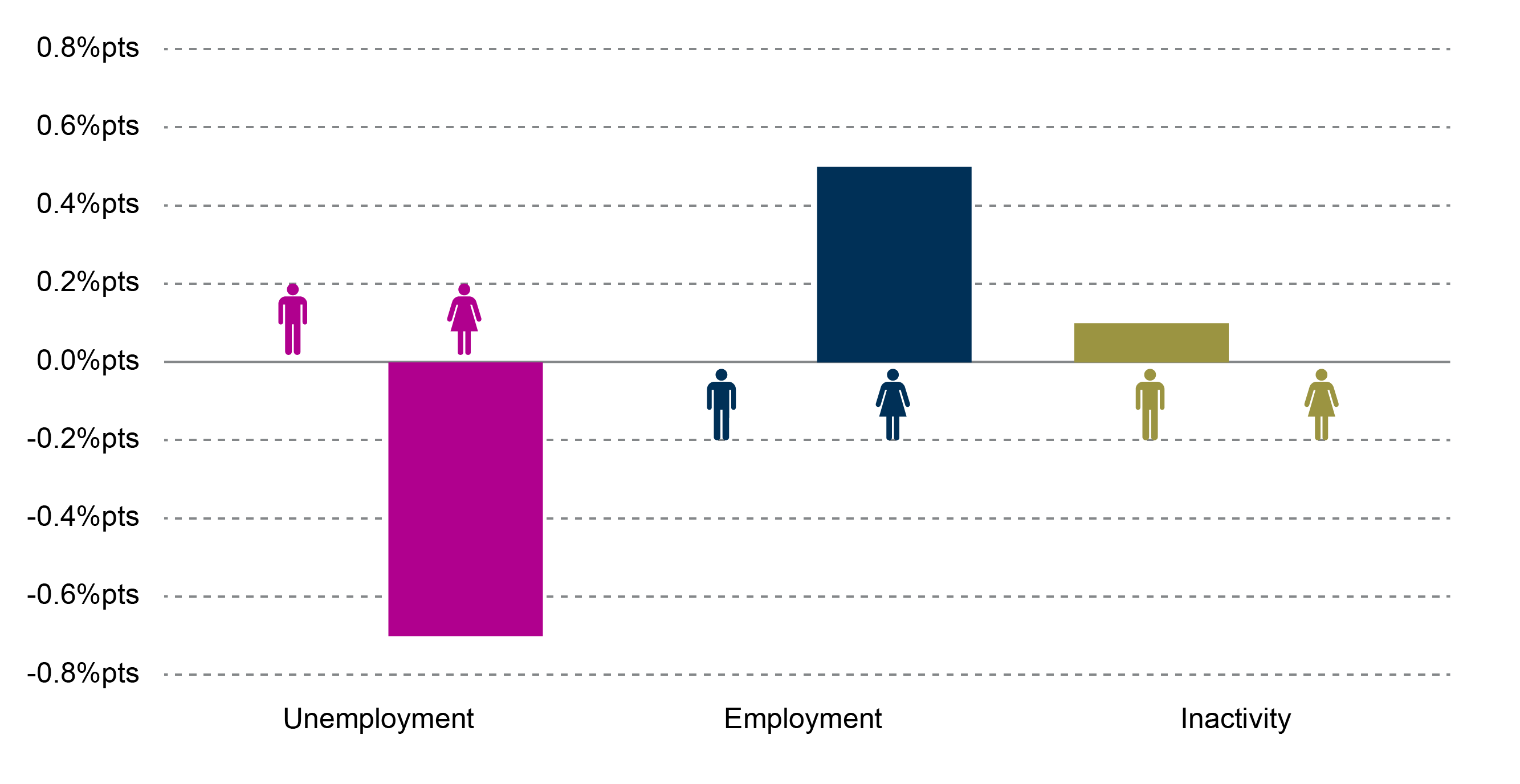
Table 1 shows the unemployment, employment and inactivity rates and the change on the previous quarter.
| Overall | Men | Women | ||||
|---|---|---|---|---|---|---|
| Rate (%) | Change over the qtr (% pts) | Rate (%) | Change over the qtr (% pts) | Rate (%) | Change over the qtr (% pts) | |
| Unemployment | 3.4% | -0.3 | 4.1% | 0.0 | 2.6% | -0.7 |
| Employment | 75.3% | +0.3 | 79.0% | 0.0 | 71.7% | +0.5 |
| Economic Inactivity | 22.0% | 0.0 | 17.5% | +0.1 | 26.3% | 0.0 |
What are the labour market measurements?
The International Labour Organisation provides the official definition of labour market statistics.
What is unemployment?
Level: Any individual aged 16 and over without a job who has been actively seeking work within the last four weeks and is available to start work within the next two weeks.
Rate: Number of unemployed individuals as a proportion of the total number of economically active people, which includes both the unemployed and those in work.
What is employment?
Level: Any individual aged 16 and over who is undertaking one hour or more a week of paid work.
Rate: Number of people in employment expressed as a percentage of all people aged 16-64.
What is economic inactivity?
Level: Any individual aged 16 to 64 who is not in employment, has not looked for work in the last four weeks, and/or is unable to start work within the next two weeks.
Rate: Number of people economically inactive expressed as a percentage of all people aged 16-64.
The main reasons for economic inactivity are:
being a student and not having or looking for a job
looking after the family and/or home
being sick (temporary and long-term)
being retired
being discouraged.
You can find out more in formation on labour market statistics in the SPICe Labour market statistics briefing.
Unemployment
The number of unemployed people in Scotland decreased by 9,000 over the quarter and by 26,000 over the year.
The unemployment rate for Scotland is 3.4%, whilst for the UK as a whole it is 3.9%. it has not been lower since November 1974 to January 1975, while the Scottish rate is the lowest since comparable records began in 1992. 1
The unemployment rate in Scotland fell over the quarter and the year at a faster rate than the UK.
| Level ('000) | Quarter change ('000) | Year change ('000) | Rate (%) | Quarter change (% pts) | Year change (% pts) | |
|---|---|---|---|---|---|---|
| Scotland | 94 | -9 | -26 | 3.4% | -0.3 | -0.9 |
| UK | 1,338 | -35 | -112 | 3.9% | -0.1 | -0.4 |
Looking at unemployment across the UK, the South West has the lowest rate at 2.9%, whilst Yorkshire and the Humber has the highest at 5.2%. The rate in Scotland is the fourth lowest across the UK.
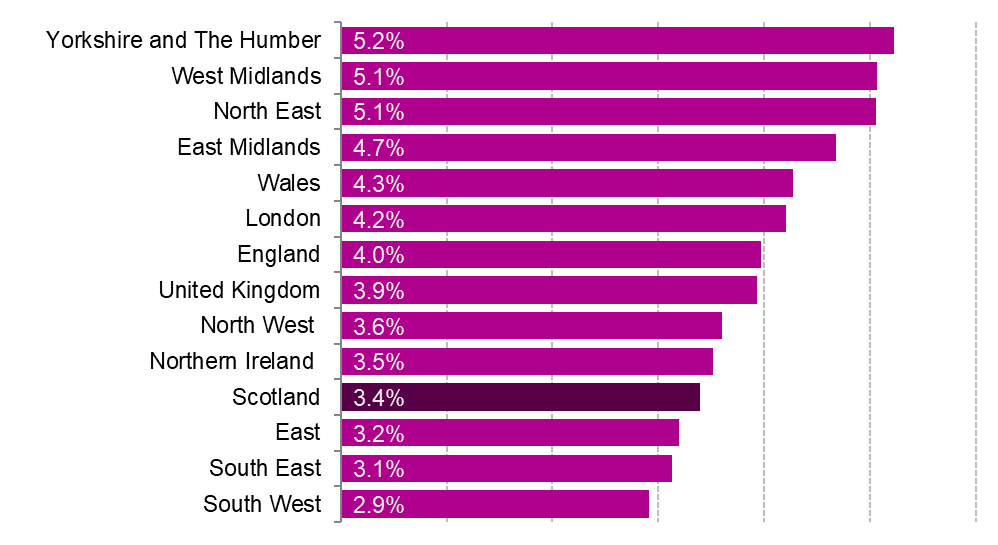
Unemployment by gender
Over the quarter the number of unemployed women decreased by 9,000 in Scotland. There was no change in the number of unemployed men.
Over the year the unemployment level fell by 26,000 in Scotland (16,000 women and 10,000 men).
The unemployment rate for men was unchanged over the quarter while it fell for women. The unemployment rate for both men and women in Scotland fell over the year.
The unemployment rate for women is the lowest since comparable records began in 1992.
The unemployment rate for women is lower in Scotland than the UK, while the rate for men is slightly higher.
| Level ('000) | Quarter change ('000) | Year Change ('000) | Rate (%) | Quarter change (% pts) | Year change (% pts) | ||
|---|---|---|---|---|---|---|---|
| Scotland | Men | 59 | 0 | -10 | 4.1% | 0.0 | -0.7 |
| Women | 35 | -9 | -16 | 2.6% | -0.7 | -1.1 | |
| UK | Men | 728 | -16 | -27 | 4.0% | -0.1 | -0.2 |
| Women | 611 | -19 | -85 | 3.8% | -0.1 | -0.6 |
Figure 3 shows how unemployment rates by gender in Scotland have changed over the past 10 years.
The unemployment rate for men peaked at 9.8% in Feb-Apr 2010. Since then it has fallen by 5.7 percentage points, but is currently 0.1 percentage point above the lowest rate in Feb-Apr 2017, of 4.0%.
The unemployment rate for women peaked at 7.9% in Nov-Jan 2012. Since then it has fallen by 5.3 percentage points to the current rate of 2.6%. This is the lowest rate since comparable records began.
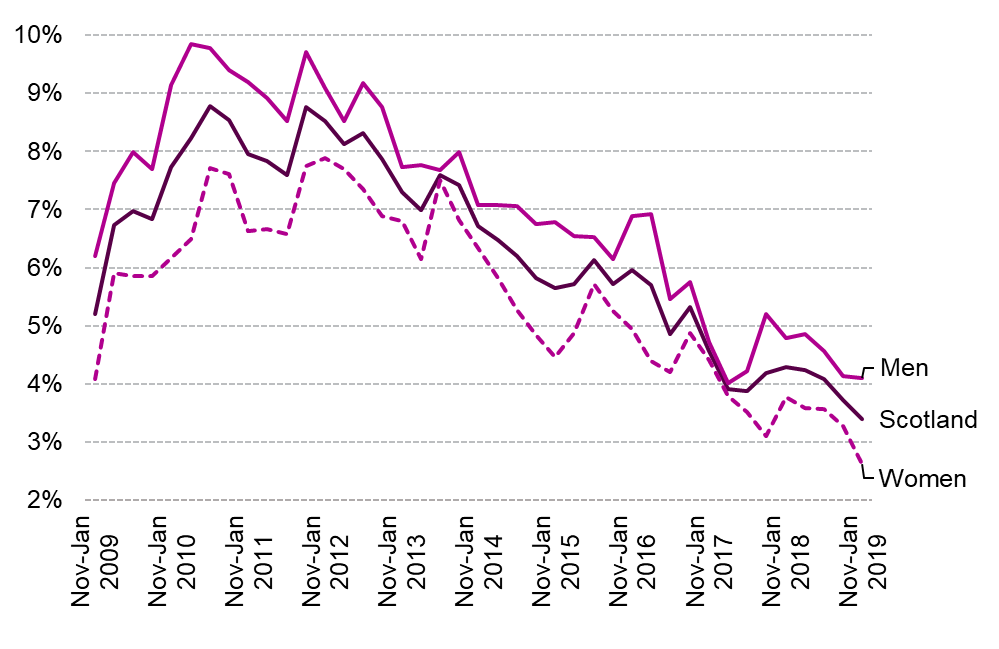
Unemployment by age
This data is not seasonally adjusted and is compared with the same quarter in previous years.
The unemployment rate for the 16 to 24 (7.4%) and 35 to 49 (1.7%) age groups is the lowest since comparable records began in 2002.
The only age group in Scotland that deviates significantly from the UK is 16-24 year olds, at 3.4 percentage points lower that the UK.
| Age group | Scotland | UK | |
|---|---|---|---|
| 16-24 | Rate | 7.4% | 10.8% |
| Year change (% pts) | -1.8 | -0.8 | |
| 25-34 | Rate | 3.9% | 3.3% |
| Year change (% pts) | +0.3 | -0.5 | |
| 35-49 | Rate | 1.7% | 2.5% |
| Year change (% pts) | -2.1 | -0.3 | |
| 50-64 | Rate | 3.3% | 2.9% |
| Year change (% pts) | -0.1 | -0.2 |
Employment
The number of people aged 16 and over in employment in Scotland increased by 13,000 over the quarter, and by 10,000 over the year.
The rate in Scotland increased over both the quarter and the year at a slower rate than the UK.
The current employment rate, of 75.3%, is the second highest since comparable records began in 1992. While the UK is the highest since comparable estimates began in 1971.1
| Level ('000) | Quarter change ('000) | Year change ('000) | Rate (%) | Quarter change (% pts) | Year change (% pts) | |
|---|---|---|---|---|---|---|
| Scotland | 2,676 | +13 | +10 | 75.3% | +0.3 | +0.5 |
| UK | 32,714 | +222 | +473 | 76.1% | +0.4 | +0.8 |
Looking at employment across the UK, the Scottish rate is below the UK. The South West has the highest rate at 79.9%, whilst Northern Ireland has the lowest at 70.9%.
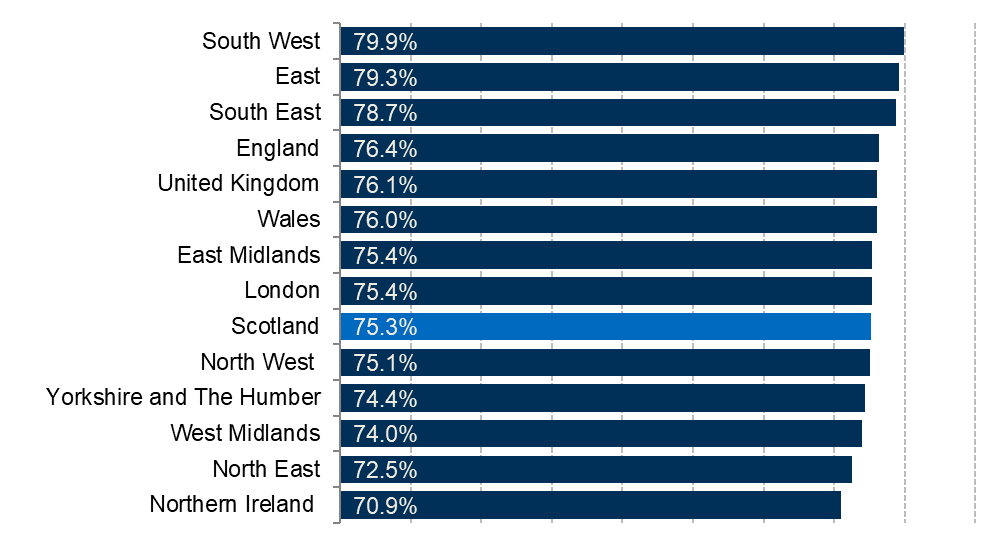
Employment by gender
Employment levels and rates are higher for men than for women at both Scottish and UK levels.
The increase in the employment level over the year was evenly split between men and women, both increasing by 6,000.
Over the year, the number of men in employment increased by 12,000, while the number of women in employment fell by 2,000.
The rate for men was unchanged over the quarter but increased over the year, while the rate for women increase over both the quarter and the year.
The employment rates for both men and women are lower in Scotland than the UK.
| Level ('000) | Quarter change ('000) | Year change ('000) | Rate (%) | Quarter change (% pts) | Year change (% pts) | ||
|---|---|---|---|---|---|---|---|
| Scotland | Men | 1,382 | +6 | +12 | 79.0% | 0.0 | +0.9 |
| Women | 1,294 | +6 | -2 | 71.7% | +0.5 | +0.2 | |
| UK | Men | 17,317 | +77 | +226 | 80.5% | +0.2 | +0.7 |
| Women | 15,396 | +144 | +246 | 71.8% | +0.6 | +0.9 |
Figure 5 shows how employment rates by gender in Scotland have changed over the past 10 years.
The employment rate for women has increased by 5.7 percentage points since Aug-Oct 2012, when it was its lowest in the last 10 years, at 66.1%. It is, however, slightly below its peak of 72.7% in Feb-Apr 2015.
The men's employment rate has increased by 6.3 percentage points since Feb-Apr 2010, when it was its lowest in the last 10 years, at 72.7%. The rate is currently slightly below the highest rate of 79.6% in May-Jul 2017.
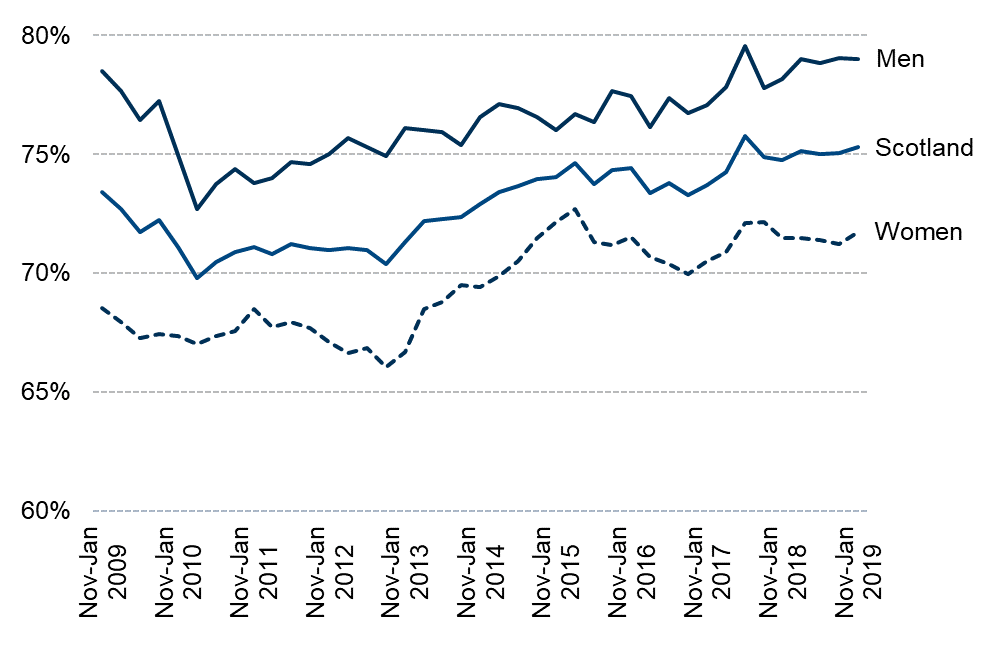
Employment by age
This data is not seasonally adjusted and is compared with the same quarter in previous years.
Despite a slight decrease over the year, the employment rate for 50-64 year olds has increased by 10.3 percentage points since 2002.
The employment rate for the 25 to 34 and 35 to 49 year old age groups is the highest since comparable records began in 2002.
The youth employment rate and the rate for 50-64 year olds both deviate from the UK, 3.4 percentage points higher and 4.2 percentage points lower respectively.
| Age group | Scotland | UK | |
|---|---|---|---|
| 16-24 | Rate (%) | 59.1% | 55.7% |
| Year change (% pts) | +0.4 | +1.4 | |
| 25-34 | Rate (%) | 84.0% | 84.2% |
| Year change (% pts) | +1.9 | +0.6 | |
| 35-49 | Rate (%) | 85.4% | 85.6% |
| Year change (% pts) | +3.7 | +0.5 | |
| 50-64 | Rate (%) | 68.1% | 72.3% |
| Year change (% pts) | -3.5 | +0.9 |
Economic inactivity
The number of people economically inactive in Scotland increased over the quarter by 1,000, and by 5,000 over the year.
The inactivity rate was unchanged over the quarter but increased over the year.
| Level ('000) | Quarter change ('000) | Year change ('000) | Rate (%) | Quarter change (% pts) | Year change (% pts) | |
|---|---|---|---|---|---|---|
| Scotland | 758 | +1 | +5 | 22.0% | 0.0 | +0.1 |
| UK | 8,549 | -117 | -194 | 20.7% | -0.3 | -0.5 |
Looking at economic inactivity across the UK, the Scottish rate is higher than the UK average. Northern Ireland has the highest rate at 26.4%, whilst the South West has the lowest at 17.6%.
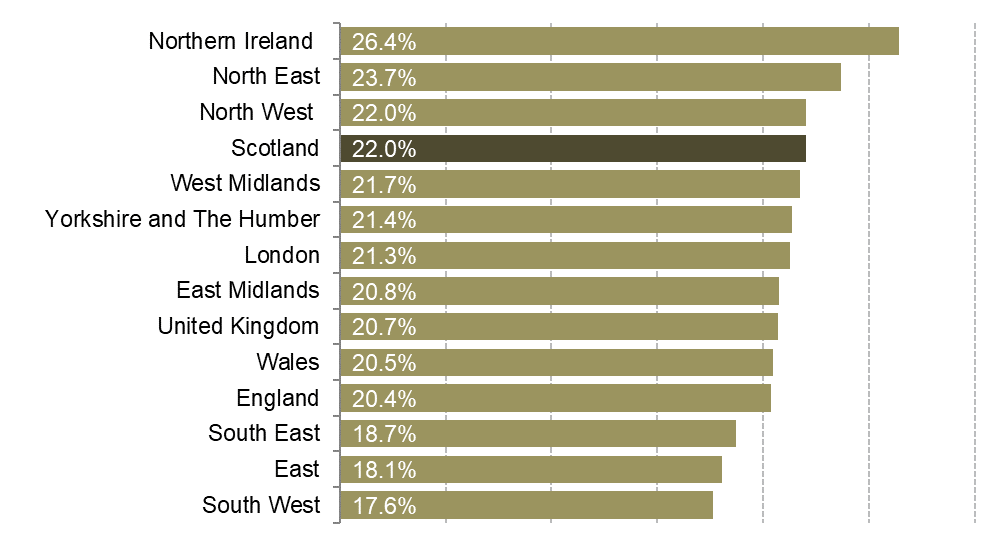
Economic inactivity by gender
Economic inactivity rates are higher for women than for men.
Over the quarter the number of inactive men increased by 1,000, whilst the number of inactive women was unchanged.
Over the the year the number of inactive men fell by 7,000, while the number of inactive women increased by 12,000.
The inactivity rates for men and women are higher in Scotland than in the UK overall.
| Level ('000) | Quarter change ('000) | Year change ('000) | Rate (%) | Quarter change (% pts) | Year change (% pts) | ||
|---|---|---|---|---|---|---|---|
| Scotland | Men | 295 | +1 | -7 | 17.1% | +0.1 | -0.4 |
| Women | 463 | 0 | +12 | 26.3% | 0.0 | +0.7 | |
| UK | Men | 3,290 | -24 | -116 | 16.0% | -0.1 | -0.6 |
| Women | 5,259 | -92 | -78 | 25.3% | -0.5 | -0.4 |
Figure 7 shows how inactivity rates by gender in Scotland have changed over the past 10 years.
The inactivity rate for men peaked in Feb-Apr 2010, at 19.2% an increase of 3.0 percentage points from Feb-Apr 2009. The inactivity rate has remained around 17.4% since May-Jul 2017.
The inactivity rate for women peaked at 29.0% in Aug-Oct 2012, it then fell to 23.5% in May-Jul 2015 and now sits at 26.3%.
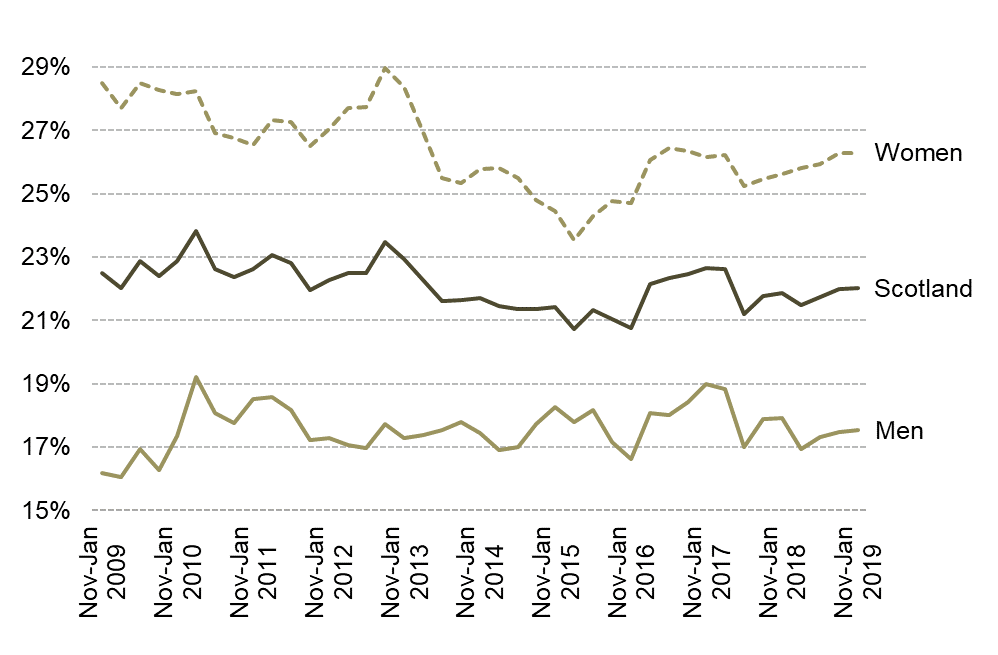
Economic inactivity by age
This data is not seasonally adjusted and is compared with the same quarter in previous years.
Despite an increase over the year, the inactivity rate for 50-64 year olds has fallen by 9.6 percentage points since 2002.
The inactivity rate for the 25-34 year old age group is the lowest since comparable records began in 2002.
The 50-64 year old age group is the only age group where the Scottish figure deviates from the UK, at 3.9 percentage points higher.
| Age Group | Scotland | UK | |
|---|---|---|---|
| 16-24 | Rate (%) | 36.1% | 37.5% |
| Year change (% pts) | 0.9 | -0.9 | |
| 25-34 | Rate (%) | 12.7% | 12.9% |
| Year change (% pts) | -2.3 | -0.1 | |
| 35-49 | Rate (%) | 13.1% | 12.3% |
| Year change (% pts) | -2.0 | -0.3 | |
| 50-64 | Rate (%) | 29.5% | 25.6% |
| Year change (% pts) | +3.7 | -0.8 |
Constituency data: inactivity
The constituency data for Scotland comes from the Annual Population Survey (APS). The APS datasets are produced quarterly, with each dataset containing 12 months of data. This data is based on residence analysis of the APS.
The latest APS data is for Oct 2017-Sep 2018.
The Orkney Islands have the lowest inactivity rate at 12.5%, whilst Glasgow Kelvin has the highest at 42.1%. Glasgow Cathcart saw the biggest decrease over the year, whilst the Shetland Islands saw the largest increase.
This data is from the resident analysis of the APS, meaning the rate is for those who live in the constituency.
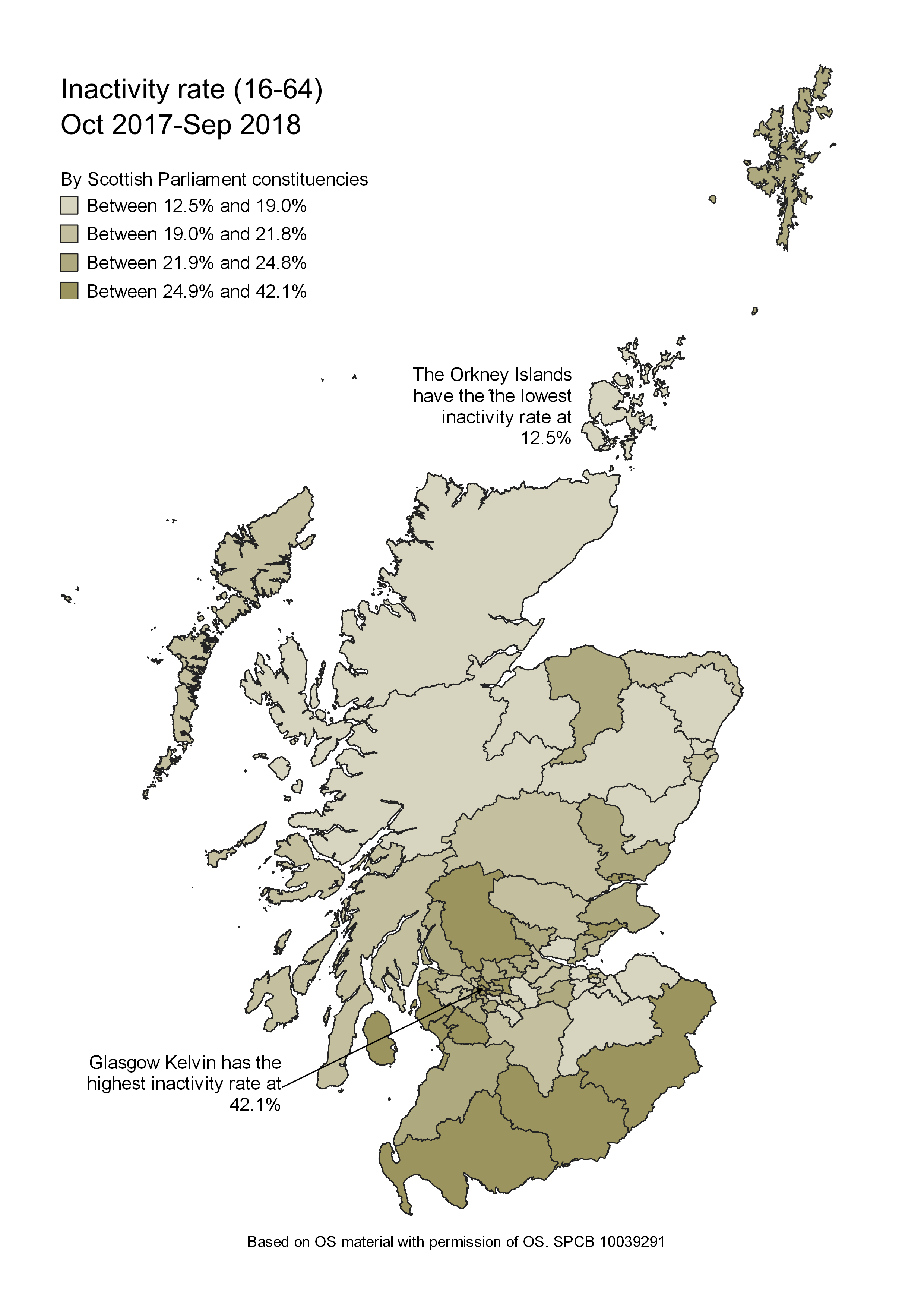
Find out the latest labour market data for your constituency.